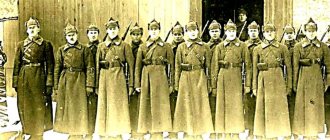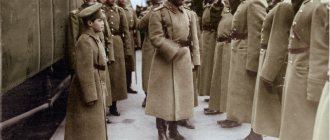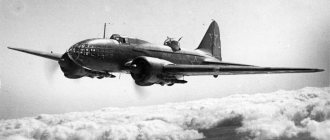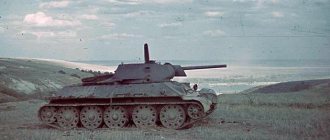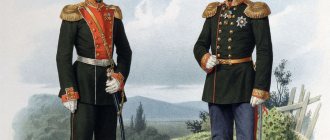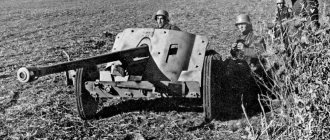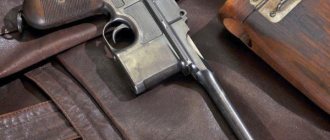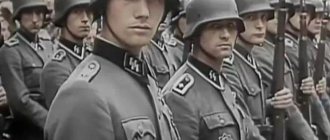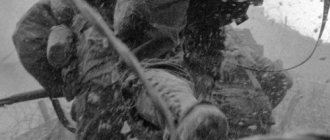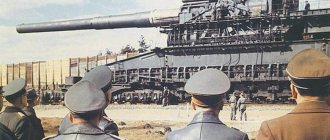“Uniforms of the Red Army 1918-1945” is the fruit of the joint efforts of a group of enthusiasts: artists, collectors, researchers, who give all their free time and money in tribute to one common idea. Recreating the realities of the era that troubles their hearts makes it possible to get closer to a truthful perception of the “central event of the 20th century” - the Second World War, which undoubtedly continues to have a serious impact on modern life. The decades of deliberate distortion of the historical truth about this war experienced by our people not only deprived us, our descendants, of a reliable and complete idea of the uniform and clothing provision of the Red Army, but also managed to sow erroneous stereotypes in the minds of generations. The created photo reconstructions will be useful not only to specialists and collectors, but also to domestic filmmakers, writers, politicians, as well as military costume reenactors.
Description of the uniform of the Red Army 1918-1936.
In December 1917, shortly after the victory of the October Revolution and the establishment of the dictatorship of the proletariat in Russia, at the so-called congress on the demobilization of the old army, it was decided to begin forming units of the new socialist army. The decree on the organization of the Red Army was issued by the Council of People's Commissars of the USSR on January 15, 1918. The formation system provided for the consolidation of volunteers from the military personnel of the old army into separate units, the creation of units from volunteers who did not serve in the old army, as well as the use of Red Guard detachments.
During this initial period, the Soviet government was unable to create a regular army and provide it economically in the conditions of private industry, private trade, sabotage of employees and disorganization of the state apparatus.
The units of the volunteer Red Army were small and unstable, staffed by elected command personnel who did not have any insignia; in terms of uniforms, they were marked by a variety of outerwear and hats, due to the winter period. The most common items were (installed in May 1912 and supplied to the rank and file of the old army) hats made of artificial astrakhan fur and cloth single-breasted overcoats.
By May 1918, a decisive transition to a regular Red Army was determined: a military administrative apparatus and a system of universal military training were created, the principle of voluntary recruitment and election of command personnel was abolished. Large-scale formation of regiments and divisions began. The introduction of the first distinctive sign indicating membership in the Red Army dates back to the same time.
On May 7, 1918, by order of the Revolutionary Military Council of the Republic (RVSR), a badge of a Red Army soldier and commander of the Red Army was established in the form of a wreath of laurel and oak branches, on top of which was attached a red five-pointed star with the “plow and hammer” emblem. On the same day, by order of the People's Commissar for Military Affairs, a competition for the best uniform was announced.
In fact, there were so many stocks of clothing left over from the old army that until the beginning of 1919, the procurement of uniforms was practically not carried out. The task of the supply authorities was only to account for and deliver supplies. But, nevertheless, in the conditions of the unfolding Civil War, it was necessary to somehow emphasize the affiliation of the personnel with the Red Army and their official position.
headdress approved on December 18, 1918 , which later received the name “budennovka”, distinctive insignia of command personnel in the form of triangles, squares and diamonds for wearing on the left sleeve, as well as sleeve insignia in the form of emblems of the main branches of the military. The cockade badge for the headdress in the form of a five-pointed star with a plow and a hammer was installed by order of the People's Commissar for Military Affairs on July 29, 1918.
1919 is characterized by the beginning of industry's work on defense. Unlike the old army, the system of using contractors was destroyed, which, however, did not lead to the centralization of clothing supplies, since suppliers everywhere actively used local resources. On April 8, 1919, the first samples of uniforms were installed: a new headdress , infantry and cavalry greatcoats, and summer shirt. On all types of clothing, buttonholes and breast flaps made of cloth were sewn in colors according to the branch of service, as well as sleeve insignia . Until the end of the Civil War, the new uniforms were used along with a variety of old army uniforms, casual items and civilian clothing.
The new Red Army star for the headdress - summer and winter helmet - approved on June 11, 1922, had a stamped image in the middle of an intersecting hammer and sickle.
In June 1923, for all special bodies of the GPU - OGPU, uniform Army with insignia of special colors, as well as trousers and a dark blue winter headdress. Internal, border troops and special forces units (CHON) were also entitled to a Red Army uniform with its own colors of buttonholes, breast flaps and a cloth star on the headdress.
The transition to combat training in peacetime conditions, which began in 1923-1924. provided for a significant reduction in the costly maintenance of personnel units of the Red Army with their partial replacement by formations recruited on a territorial basis. At the same time, it was considered necessary to reduce the cost of production of military clothing, making it more practical and eliminating unnecessary differences in the Red Army uniform, which lost their significance with the end of the Civil War.
On May 13, 1924, instead of the impractical summer headdress of the 1922 model, summer cap made of khaki cotton fabric was introduced. summer tunic shirt was introduced Subsequently, in June-July 1924, all the main items of uniform were changed and new insignia .
The official position of a serviceman in accordance with the assigned category was henceforth determined by metal insignia: triangles, squares, rectangles (since 1925), rhombuses, covered with red enamel and placed on buttonholes . The set of color schemes for buttonholes of various branches of the military was reduced to a minimum, the number of badges for specialties - emblems - was reduced, and sleeve insignia were abolished.
At first, no differences were envisaged between the uniforms of Red Army soldiers and commanders, but already on August 4, 1924, in connection with the transition to strengthening unity of command, significant differences were introduced in the cut of the jacket for the command, administrative, economic and political composition of the Red Army . Immediately after this, on August 8, 1924, the Revolutionary Military Council of the USSR approved dark blue uniforms for the air force and sleeve insignia for military pilots and military aeronauts.
The uniform of the organs and troops of the OGPU in 1924 underwent similar changes. In addition, by the beginning of 1925, only two versions of buttonholes were retained for the OGPU - maroon and light green - and two samples of colored cloth caps corresponding to them were introduced.
In 1926, the Red Army achieved one hundred percent provision of military personnel with clothing in accordance with all standards and reports. This made it possible to establish clear rules for wearing uniforms, which were announced by order of the Revolutionary Military Council of the USSR on February 26, 1926. According to these rules, uniforms were divided according to the time of use - into summer and winter, by purpose - into everyday, guard and marching (the difference was determined only by the level of equipment weapons and equipment). Mixing military uniforms with non-uniform clothing was prohibited, and the wearing of insignia, awards and badges was regulated.
In order to increase the service life of the summer headdress and improve its appearance, on February 4, 1928, for all branches of the Red cloth cap was installed For the cavalry and horse artillery, a year earlier, cloth caps of a special color were introduced, assigned to each regiment. Colored cavalry caps lasted almost three years before they were completely replaced by a uniform cap, introduced on January 12, 1929.
By the beginning of the 30s. In the USSR, great strides were made in standardizing products ordered from industry. The Red Army's clothing supply department periodically approved detailed technical specifications for new items of uniform and equipment. On November 18, 1932, taking into account the new types and standards of clothing supplies, new “Rules for wearing uniforms by military personnel of the Red Army” were issued, which were in force until 1936.
The increased importance of armored forces and aviation, changes in their organization and the rapid saturation with new equipment required increased attention to the personnel of these branches of the military. On April 10, 1934, a meeting of the People's Commissar for Military and Naval Affairs approved a new uniform for commanding personnel - aviators and tank crews - to be worn from January 1, 1935. The new uniform included a colored cap with a “square” fiber visor, an open jacket and trousers with piping, as well as a double-breasted overcoat. For the armored forces, the uniform had a steel color and red trim, for the air forces it was dark blue and light blue trim.
By the end of 1935, the final transition to the creation of armed forces built entirely on the personnel principle was ripe. On September 22, 1935, the Supreme Council of the USSR, instead of outdated job categories, established personal military ranks for the command staff of the Red Army, after which a general certification was carried out within two months. In connection with these events, a large change of uniforms was prepared.
On December 3, 1935, the People's Commissar of Defense signed an order introducing new uniforms and insignia for all personnel of the Red Army. The insignia and the uniform itself with its distinctive details as a whole constituted a strictly verified system that made it possible to accurately determine a serviceman’s belonging to the branch of the military or service, as well as to a certain composition within the branch of the military.
Military ranks reflecting the specialty corresponded to the ranks of command personnel and were grouped as follows: military-political personnel, military-technical, military-legal, military-economic and administrative, military-medical and military-veterinary. Command, military-political, military-technical and military-legal personnel wore uniforms of various branches of the military, and the command staff of the quartermaster, military medical and military-veterinary services, regardless of the type of troops, were entitled to a single uniform with the emblems of the corresponding service.
The military personnel of the command staff were distinguished by the edging of their buttonholes made of gilded braid and sleeve insignia - squares, corresponding to the assigned rank. The highest military rank - Marshal of the Soviet Union - provided for special distinctions: large stars embroidered with gilded tinsel on diamond-shaped buttonholes edged with gilded thread, the same stars on the sleeves and sleeve chevrons made of wide gilded braid; The band of the cap , buttonholes and edging are red.
The system of personal military ranks provided for special ranks for military political workers. “Political instructors” (up to a level equal to the rank of “ captain ”) and (more senior) “commissars” had on all types of clothing sleeve insignia of the political staff - red five-pointed stars with an image of a hammer and sickle embroidered in gilded thread. According to the rules for wearing uniforms, issued on December 17, 1936, political workers of all branches of the military (except for students of military academies) were not supposed to wear the emblems of the military branches on their buttonholes. This emphasized independence from unit commanders, to whom on May 10, 1937, political workers were officially equal in rights, just as was the case before 1925. When in July–August 1940, during the period of strengthening unity of command, the commissars of units and subunits were moved to the positions of deputy commanders for political affairs, all political workers were required not only to wear the lapel emblems of their branch of the army, but also to master the corresponding military specialty.
The military-technical personnel - “military technicians” and “military engineers” - did not have sleeve insignia (with the exception of the technical insignia of the Air Force ) and wore the uniform and buttonholes of all branches of the military, distinguished only by the emblem in the form of a crossed hammer and French key. From January to September 1942, engineers of all branches of the military were gradually assigned command ranks with the prefixes technician ("technician-lieutenant") and engineer ("engineer-colonel"), as well as all the distinctions of the command staff - sleeve insignia and gold edging buttonholes
The rank of quartermaster was held by command personnel of all military branches who performed economic and administrative tasks. The personnel of the quartermaster service were entitled to their own uniform of a general army standard in khaki color with red edging without sleeve insignia, with a cap band and dark green buttonholes. The distinctive emblem depicted a wheel with an overlaid French key, compass and helmet. In 1942, with the introduction of regular ranks, the economic and administrative staff of each branch of the army was given a uniform identical to the command staff of this branch of the army, and commander insignia with an emblem on the buttonholes in the form of a sickle and a hammer with a superimposed red star.
The medical and veterinary personnel of the Red Army bore the ranks of “voenfeldsher” (“voenvetfeldsher”) and “military doctor” (“military veterinarian”) at various levels. The uniform differed from the lapel emblem established for quartermasters in the form of a bowl entwined with a snake. The golden emblem denoted the medical service, the silver one the veterinary service.
According to the “Regulations on the clothing and baggage supply of the Red Army in peacetime,” approved on May 27, 1936, the main set of uniforms required by the standards for the commander and the Red Army soldier consisted of a cap with a colored band according to the branch of service (for ordinary personnel - with a top made of cotton fabric), cap , winter helmet , cloth tunic or jacket (for command personnel), cotton tunic, cloth and cotton trousers and overcoat. In addition, the rules for wearing uniforms, approved on December 17, 1936, during the winter period allowed wearing felt boots or felt boots , sheepskin coats, bekesha, a Finnish cap, a leather coat or jacket, as well as a muffler.
All general army uniforms were the same color - khaki and gray, with the exception of the armored forces, all of whose uniform items were steel-colored, and the air force , where command personnel were required to wear dark blue uniforms (except for summer ones), and ordinary personnel were required to wear the usual all-army uniform.
On April 20, 1936, the Central Executive Committee of the USSR issued a resolution “On the removal of restrictions on service in the Red Army for the Cossacks.” Following this, on April 23, by order of the People's Commissar of Defense, a description of a special uniform for the Terek, Kuban and Don Cossack units was announced.
Cossack uniforms stood out sharply due to the cut of their items, as well as their colors, which made it possible to distinguish their “military” affiliation. For commanding officers, rank and file and long-term service, uniforms differed in materials and finish. Fur hats and hats were used as headdresses in full dress uniform and in winter.
Red Army soldiers in bersaglia!
Since 1917, the White troops waged a fierce armed struggle against the Red Army for six years, but were ultimately defeated. Every schoolchild knows this. And although there were quite a lot of reasons for the Reds’ victory, it is obvious that it happened not so much because of the correct policy of the latter, but because of the successful use of... PR technologies, albeit on a purely intuitive level! No wonder, apparently, the white general A.A. von Lampe believed that “the whites could defeat the reds if they themselves, in their methods, in their activities ... became red too.” The beginning of the Civil War on both sides was marked by an unprecedented surge of enthusiasm and self-sacrifice. As for uniforms, at first they fought for the most part in whatever. In 1919, the Reds found and plundered warehouses that contained uniforms designed back in 1916 by the artist Vasnetsov: a headdress similar to a hero’s helmet and multi-colored breast fasteners for various branches of the military. So the Red Army soldiers, as well as the White Guards, wore the uniform of the tsarist army, only the Reds received a new type of uniform, sewed a star on their helmet (later they began to call it Budyonnovka, the original name was Bogatyrka) - and order! By 1919, the process of stabilizing white political power had begun. regions of Russia, and the Reds - in its center, this led to some certainty in the appearance of the fighters, but what is even more significant - both of them had their own specific symbols. It was important for whites to emphasize their loyalty to Orthodoxy and the national unity of Russia. The main motive of the Reds is the destruction of everything old and the construction on its ruins of a “communist paradise” for the proletariat and, first of all, for themselves. At the II All-Russian meeting of domestic organizers, held on June 12, 1920 in Moscow, Lenin o (bersaglie - equipment of Italian motorcyclists).
Photos of the uniform of the Red Army 1918-1936.
| Red Army soldier, 1918 | Red Army soldier, volunteer of the Bashkir Red Army, 1918 | Commissioner, 1918-20 |
| Company commander, 1919 | commander , 1920-22. | Commander of the cavalry division, 1920-22. |
| Infantry shooter in winter camouflage, 1920-21. | Military director of the OGPU Inspectorate, 1923. | Red Army soldier in summer uniform, infantry, 1923-24. |
| Red Army soldier in winter uniform, infantry, 1923-24. | Red Army soldier in summer uniform, infantry, 1924. | Representative of the OGPU leadership in winter uniform. 1924 |
| OGPU employee in everyday uniform, 1924-27. | Assistant Battalion Commander in Field Uniform, Infantry, 1925-26. | Presiding officer of a military tribunal in winter uniform, 1924 |
| Head of the station department of the OGPU. Transport departments of the OGPU, 1925-34. | Assistant commander of a separate squadron, cavalry, 1927-29. | Red Army soldier in field uniform, armored forces, 1931-34 |
| Red Army soldier, cavalry, 1931-36. |
Long story
The history of the Workers' and Peasants' Red Army is an eventful entire period in the history of the Soviet state. Despite its rather young age, the Red Army is an organized armed force, rich in its traditions and glorious history. There were moments in her full of tragedy and despair. Political repressions in the Red Army of 1936-39, which covered all army structures from the very bottom to the very top, caused significant damage to the country's combat capability.
Despite this, the Red Army was able to withstand with honor and dignity the tests of fire and sword that befell it during the harsh years of World War II. Formally, the history of the Red Army ended on February 25, 1946, when, by order of the Council of Ministers of the USSR, the Workers' and Peasants' Red Army was reorganized into the Soviet Army, which became the successor to the armed forces of the world's first socialist state.
Description of the uniform of the Red Army 1936-43.
Noticeable differences from the army uniform were received by the command staff of the bodies and troops of the NKVD of the USSR, introduced on December 27, 1935. This was preceded by the decision of the Politburo of the Central Committee of the All-Union Communist Party of Bolsheviks of September 10, 1935, according to which all organizations, institutions and individuals were prohibited from wearing uniforms and insignia , similar or similar to the Red Army. However, the situation soon changed, and already on July 15, 1937, by order of the People's Commissar of Internal Affairs, the same uniform was introduced for all NKVD personnel as in the Red Army with minor differences in the cut of some items.
An unusual uniform was introduced on October 27, 1936 for full-time command, teaching staff and students of the newly formed General Staff Academy. The main features of this uniform were a black velvet French collar, tunics and overcoats, white piping and stripes on the trousers. Taking advantage of the fact that the “infantry” crimson color was established for the buttonholes, cap and stripes, those who preferred to save sewing money wore ordinary breeches for infantry command personnel with crimson edging and without stripes when wearing a tunic. This colorful uniform was canceled on May 22, 1940, shortly before the introduction of uniforms for Red Army generals.
Based on the results of the assessment of the military operations against Finland (December 1939 - March 1940), a number of decisions were made to reorganize the military command system in order to ensure clear unity of command. As one of the measures to strengthen the authority of command personnel, on May 7, 1940, general ranks were established for the senior command staff of the Red Army and on July 13, 1940, general uniforms and insignia .
Similar to the uniform of pre-revolutionary Russian generals were: a khaki -colored jacket with breast welt pockets, trousers with stripes, a hat and an edged overcoat with “coat of arms” buttons. The cut of the single-breasted dress uniform was borrowed from the German army. In addition to the above, the generals of the Red Army were entitled to a cap (ceremonial and everyday) with a round gilded cockade, a ceremonial overcoat and a white cotton jacket .
The main insignia were placed on diamond-shaped buttonholes edged with gilded thread. The ranks of combined arms generals (red buttonholes ) were indicated by gilded metal stars, and the ranks of generals of artillery and tank forces (black buttonholes ), as well as aviation (blue buttonholes ), signal troops, engineering troops, technical troops and quartermaster service (crimson buttonholes ), in addition , also with a gilded emblem of the corresponding branch of the military. Marshals of the Soviet Union, when wearing a general's uniform, were entitled to red buttonholes decorated with gold embroidered stars in a hammer and sickle pattern with intersecting laurel branches, gold embroidered sleeve squares (also with laurel branches) and large sleeve stars.
While the senior command staff was preparing to try on the new general uniform, the insignia of the middle and senior command staff were changed. On July 26, 1940, by order of the People's Commissar of Defense, their new description was announced. The gold edging of the buttonholes of commanders, from junior lieutenant to colonel, was now done with gilded thread, and the sleeve insignia of command personnel acquired a brighter appearance: the squares of the new type differed in the number and width of gold braid with gaps and edging made of red cloth.
No less serious attention was paid to increasing the level of responsibility and raising the authority of the junior command level. On November 2, 1940, the People's Commissar of Defense signed an order establishing military ranks for private and junior command personnel and approved the “Regulations on the service of junior command personnel,” which established strict conditions for obtaining corporal and sergeant ranks and contained a detailed description of the new insignia.
The new type of junior command buttonholes, which were supposed to begin wearing on January 1, 1941, were equipped with a narrow red gap in the middle and a yellow metal triangle in the upper corner. On the buttonholes for petty officers, in addition, a narrow gilded braid was sewn parallel to the edging. The signs denoting ranks, starting with “junior sergeant,” were enamel triangles, which previously corresponded to the positions of junior commanders.
By the beginning of 1941, there was a serious need to reduce the variety of uniforms of the Red Army and, most importantly, to revise the standards for clothing supplies for military personnel. In this regard, it was decided to introduce for the supply of personnel uniforms that were not only uniform in color and pattern for all branches of the military, but also universal for the preparation of uniforms that differ in purpose and time of use. Many items were to be abolished - such as open jackets of the Air Force and armored forces, Cossack uniforms - which made the prestige of their branches of the military, but made it difficult to supply and maneuver with supplies. To solve this problem, it was necessary to significantly improve the input form, without advertising all the changes made.
The corresponding order of the People's Commissar of Defense, issued on February 1, 1941, was classified “top secret.” Of all its contents, only the following were made public: the transition to a single color of uniforms, the introduction of new, more popular fabrics, and the gradual introduction of beautiful ceremonial uniforms to supply combat units. The supply standards for commanding and rank and file personnel established for peacetime and wartime were not subject to disclosure. According to these standards, the simple uniform that was to be accumulated by the beginning of the mobilization deployment of the army consisted of: a khaki cap (in winter - a cap with earflaps, model 1940), a tunic with khaki trousers (for ordinary personnel - only a cotton tunic in winter and summer) and a single-breasted dark gray overcoat with hook-and-eye closure. For the winter period, in addition, the following were provided: a short fur coat or a padded jacket with a padded jacket (for the command staff - a fur vest ), cotton trousers, fur mittens and felt boots .
Photos of Red Army uniforms 1936-1943.
| Marshal of the Soviet Union in everyday uniform, 1936-40. | Red Army soldier, infantry, 1936 | Senior political instructor, artillery, 1936-40. |
| Military engineer 2nd rank, technical troops, 1936-43. | Quartermaster 2nd rank to everyday uniform, 1936-42. | Second Lieutenant , Air Force . 1941 |
| Captain , artillery motor transport units, 1936-40. | First Lieutenant in casual uniform, Air Force , 1936-40. | Red Army soldier in summer overalls, armored forces, 1935. |
| Lieutenant in marching uniform, armored forces, 1938-41. | Captain , Air Force, 1936-40. | Lieutenant in flight uniform, Air Force, 1936-43. |
| Detached commander , motor transport units, 1938-40. | Protective anti-chemical clothing , 1936-45 gt. | Brigade commander in everyday uniform of the General Staff Academy, 1936-40. |
| Senior lieutenant of State Security in everyday uniform, NKVD, 1936-37. | Senior lieutenant of State Security in everyday uniform, NKVD, 1936-37 | Senior lieutenant of State Security in winter uniform. NKVD. 1936-37 |
| Sergeant of State Security, NKVD, 1937-43. | Major , internal troops of the NKVD 1937-43. | Junior political instructor in summer field uniform, infantry, 1939. |
| Red Army soldier, NKVD border troops 1937-41. | Shooter in winter camouflage, 1939-40. | Shooter in winter field uniform, 1936-41. |
| Red Army soldier and full dress uniform of Kuban Cossack cavalry units, 1936-41. | Red Army soldier in full dress uniform of the Don Cossack cavalry units, 1936-41. | Major in full dress uniform of the Terek Cossack cavalry units, 1936-41. |
| Junior lieutenant in full dress uniform of the mountain cavalry units, 1936-41. | Marshal of the Soviet Union in everyday uniform, 1940-43. | Major General in full dress uniform, 1936-41. |
| Major General of Tank Forces in everyday uniform, 1940-43. | Major General in marching uniform, 1940-43. | Lieutenant General in summer uniform, 1940 |
| Major General of Aviation in summer uniform, 1940-41. | Lieutenant in summer casual uniform, infantry, 1940-43. | Lieutenant in marching uniform, NKVD border troops, 1940-43. |
| Lieutenant Colonel in everyday uniform, artillery, 1940-43. | Senior Battalion Commissar, Artillery, 1940-41. | Captain in casual uniform, armored forces, 1940-41. |
| Captain in casual uniform, Air Force, 1940-41. | Lieutenant in casual uniform, Air Force, 1940-41. | Captain in summer uniform, Air Force, 1940-41. |
| Red Army soldier, cavalry, 1940-41. | Junior Sergeant , Infantry. 1941 | Junior sergeant , infantry, rear view 1941 |
| Corps commissar in everyday uniform, infantry, 1941-42. | Corps Commissar, Infantry, 1941-42. | Battalion commissar in full dress uniform, infantry, 1941. |
| cadet in full dress uniform, 1941. | Red Army soldier in full dress uniform, infantry. 1941 | Lieutenant Colonel in winter casual uniform, artillery, 1941-43. |
| Lieutenant , infantry. 1941 | Lieutenant in wartime marching uniform, ground forces. 1941-43 | Major , Air Force, 1941-43. |
| Major , cavalry, 1940-43 | Red Army soldier in winter uniform, engineering troops, 1941-43. | Junior lieutenant in marching uniform, armored forces, 1941-43. |
| Sniper in summer camouflage. 1941-45 | Scout in summer camouflage, 1941-42. | Sniper in autumn camouflage, 1941-45. |
| Observer fighter of the MPVO self-defense group, 1941-44. | Corporal to marching uniform, infantry, 1941. | Corporal , infantry, rear view, 1941 |
| Red Army soldier, ground forces, 1941-43. | Junior lieutenant and wartime marching uniform, ground forces, 1941-43. | Senior Red Navy man, 1940-41. |
| Engineer, captain 2nd rank . Navy . 1941-43 | Red Army soldier, armored forces, 1941-42. | Red Army soldier, ground forces, 1941-43. |
| Red Army soldier, cavalry. 1941-42 | Taiki commander in winter uniform. 1942-44 | Captain 3rd rank , Navy . 1942-43 |
| Naval aviation pilot, 1941-45. | Submachine gunner, mountain rifle units, 1942-43. |
Source: A. Shalito, I. Savchenkov, N. Roginsky, K. Tsyplenkov - Uniform of the Red Army 1918-1945″ [2001]
